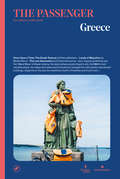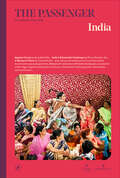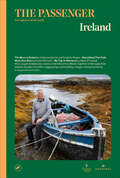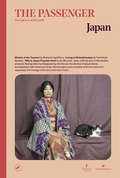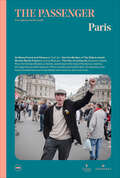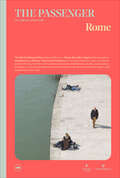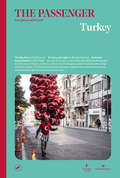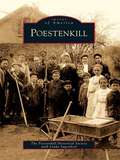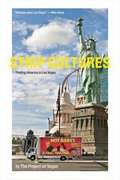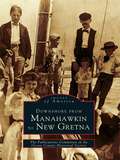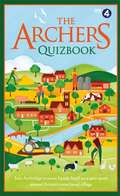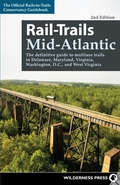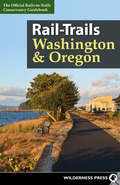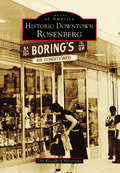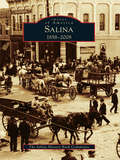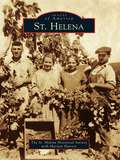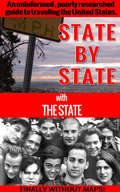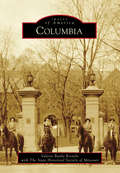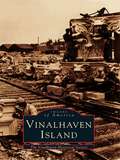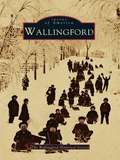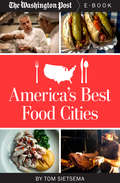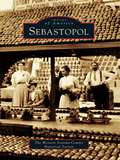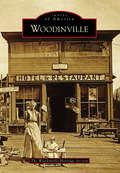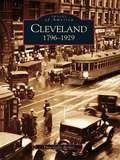- Table View
- List View
The Passenger: Greece (The Passenger)
by The PassengerA vivid portrait of life in Greece, in the series that collects the best new writing, photography, art and reportage from around the world.Many have impressions and opinions about Greece based on superficial headlines or pop culture stereotypes. This volume of The Passenger offers instead a wide-ranging, thoughtful, and lively picture of the country in all its nuance and diversity—its people, its problems, its art, its athletes, and much, much more.“The Passenger readers will find none of the typical travel guide sections on where to eat or what sights to see. Consider the books, rather, more like a literary vacation.” —Publishers WeeklyIn this volume:Once Upon A Time: The Greek Taverna by Petros Markaris Land of Migration by Matteo Nucci The Lost Generation by Christos Ikonomou Plus: Yorgos Lanthimos and the “Weird Wave” of Greek cinema, the island where people forget to die, the NBA’s most valuable player, the mayor who balanced the books but enraged the nationalists, abandoned buildings, oligarchs on the rise, the rebellious rhythm of rebetiko and much more . . .
The Passenger: India (The Passenger)
by The PassengerA journey into today’s India through essays, photography, and more, shortlisted for a 2022 Edward Stanford Travel Writing Award.Since its earliest interactions with the West, India has been the object of a gross misinterpretation, a vague association with ideas of peace, spiritualism, the magic of the fakirs. Constantly reframed and mythologized by Westerners fleeing their supposedly rationalist societies, India continues to fascinate with its millennia-old history, shrines on every street corner, ancient beliefs and rituals, and unique linguistic and cultural diversity.Today this picture is mixed with that of a society changing at a frenetic pace and at the forefront of the digital revolution—a “shining India” of dynamic, fast-expanding megalopolises. Yet these success stories coexist with the daily plight of the large section of its population without access to drinking water or a toilet, with a rural economy (still employing the majority of its over 1.3 billion inhabitants) that depends on monsoons for irrigation and is threatened by climate change. The greatest democratic experiment ever attempted, India remains plagued by one of the vilest forms of class and racial discrimination, the caste system, exacerbated by the Hindu nationalist regime.All things considered, though, it’s hard to find a more dynamic and optimistic country or, as Arundhati Roy puts it, “a more irredeemably chaotic people.” This volume aims to depict India’s chaos and its contradictions, its terror and its joy, from the struggle of the Kashmiris to that of non-believers (hated by all religious sects), from the dances of the hijra in Koovagam to the success of the wrestler Vinesh Phogat, a symbol of the women who seek to free themselves from the oppressive patriarchal mores. Despite the obstacles and steps back, India continues its journey on the long path toward freedom and toward ending poverty for some of the world’s most destitute. Included are writings on:Caste: Yesterday, Today, and Tomorrow by Arundhati Roy · The Invention of Hindu Nationalism by Prem Shankar Jha · No Country for Women by Tishani Doshi · Plus: the grand ambitions of the world’s most underrated space program, Bollywood’s obsession with Swiss landscapes, an ode to Bengali food, eagerly awaiting the monsoon, the wrestler tackling stereotypes and much more . . . “These books are so rich and engrossing that it is rewarding to read them even when one is stuck at home.” —The Times Literary Supplement
The Passenger: Ireland (The Passenger)
by The PassengerThe best new writing, photography, art, and reportage from and about Ireland—in the series that’s “like a literary vacation” (Publishers Weekly).Ireland is a land full of charm and conflict, a country that in just a few decades has gone from being a poor, semi-theocratic society to a thriving economy free from the influence of the Catholic Church. With the 1998 peace agreements, the conflict between nationalists and unionists seemed, if not resolved, at least dormant. But Brexit—with the ambiguous position it leaves Northern Ireland in—caused old tensions to resurface, with ramifications in politics, society, culture, and sport.Meanwhile, south of the border, epochal transformation has seen a deeply patriarchal, conservative society give space to diversity, the only country in the world to enshrine gay marriage in law through a referendum. And there’s a whole other Ireland abroad, an Irish diaspora that looks to the old country with newfound pride but doesn’t forget the ugliness it fled from.Memory and identity intertwine with the transformations—from globalization to climate change—that are remodeling the Irish landscape, from the coastal communities under threat of disappearing along with the Irish language fishermen use to talk about the sea, inland the peat bogs, until recently important sources of energy and jobs, are being abandoned. Pieces in this collection include:The mass is ended by Catherine Dunne and Caelainn Hogan · The Way Back by Colum McCann · A Trip to Westeros by Mark O’Connell · Plus: life on the margins of two unions and right in the middle of Brexit, making war on each other for thirty years while playing on the same national rugby team, emigrating to the great enemy or transforming the country one referendum at a time, digging peat bogs and building cottages, talking of the sea in Gaelic, and much more . . . “These books are so rich and engrossing that it is rewarding to read them even when one is stuck at home.” —The Times Literary Supplement
The Passenger: Japan (The Passenger)
by The PassengerExplore Japanese society in the lively series that collects the best new writing, photography, art, and reportage from around the world.Visitors from the West look with amazement, and sometimes concern, at Japan’s social structures and unique, complex culture industry; the gigantic scale of its tech corporations and the resilience of its traditions; the extraordinary diversity of the subcultures that flourish in its “post-human” megacities. The country nonetheless remains an intricate and complicated jigsaw puzzle, an inexhaustible source of inspiration for stories, reflections, and reportage. Caught between an aging population and extreme post-modernity, Japan is an ideal observation point from which to understand our era and the one to come. The subjects in this volume form a portrait of the country that ranges from the Japanese veneration of the dead to the Tokyo music scene, from urban alienation to cinema, from sumo to toxic masculinity.“The Passenger readers will find none of the typical travel guide sections on where to eat or what sights to see. Consider the books, rather, more like a literary vacation.” —Publishers WeeklyIn this volume:Ghosts of the Tsumani by Richard Lloyd Parry Living in Shimokitazawa by Yoshimoto Banana Why Japan Has Avoided Populism by Ian Buruma Plus: a Shinto sect in the shadow of power, fleeing debts by disappearing into thin air, the decline of sexual desire, the obsession with American blues, the strongest sumo wrestler of all time (who isn’t Japanese), the revenge of the Ainu and much more . . .
The Passenger: Paris (The Passenger)
by The PassengerThe best new writing, photography, art, and reportage from and about Paris—in the “rich and engrossing” series for literary travelers (Times Literary Supplement).Paris’s postcard image has suffered multiple blows in recent years: the November 2015 terrorist attacks, the demonstrations of the yellow vests, the riots in the suburbs, Notre-Dame in flames, record heatwaves and the coronavirus. Meanwhile, soaring living costs are forcing many Parisians to leave the city.Yet these are not just a series of unfortunate events. They are phenomena—from increasing population density to climate change, from immigration to the repercussions of globalization and geopolitics—that all metropolises in the world must face. And in Paris, today, the mood is not one of defeat but of renewal: from the city’s ongoing environmental and urbanistic transformation to the fight by a new generation of chefs against the traditionalism of starred restaurants; from the children of immigrants who take to the streets for the right to feel French to the women determined to break the sexism and stereotypes that dominate the fashion industry. Is there anyone who seriously thinks they can teach Parisians how to make a revolution? This volume includes:Out of the Shadows by Tash Aw · Against the Stars by Tommaso Melilli · Afraid of Being Free by Samar Yazbek · Plus: the Champs-Elysées between luxury and riots, the French Republic between anti-Semitism and Islamophobia, the most elegant Congolese dandies of all time, one Parisian woman you will not encounter, the city’s legendary football team that is not the PSG, and much more . . . “The Passenger readers will find none of the typical travel guide sections on where to eat or what sights to see. Consider the books, rather, more like a literary vacation.” —Publishers Weekly
The Passenger: Rome (The Passenger)
by The PassengerThe best new writing, photography, art, and reportage from and about Rome—in the series that’s “like a literary vacation” (Publishers Weekly).If you believe recent chatter about Rome—in the media and by its residents—the city is on the verge of collapse. Each year, it slips further down the ranking of the world’s most livable cities. To the problems faced by all large capitals—hit-and-run tourism, traffic, the divide between elegant, Airbnb-dominated city centers and run-down suburbs—in recent years Rome seems to have added a list of calamities of its own: a string of failing administrations, widespread corruption, the resurgence of fascist movements, rampant crime. A seemingly hopeless situation, perfectly symbolized by the fact that Rome currently leads the world in the number of self-combusting public buses.One might expect mass migration in the face of problems like these—yet the vast majority of Romans don’t think for a second of “betraying” their hometown, and the many newcomers who’ve populated it in recent decades resemble the natives in the profound love that binds them to the city.The largest metropolis in Europe is a place of contradictions and opposites. We think of it as ancient, but it is profoundly modern—it was founded almost three millennia ago, but 92 per cent of its buildings have been built after 1945. To understand Rome and fix its problems, we should start considering it a normal city, not unlike Chicago or Manchester . . . just incomparably more beautiful. This volume is filled with portraits of Rome and thoughts not just on its famous past but its present and future, including:Rome doesn’t judge you by Nicola Lagioia · The soul of the city by Matteo Nucci · 39 memos for a book about Rome by Francesco Piccolo · Plus: a guide to the sounds of Rome by Letizia Muratori; the feigned unrest and real malaise of the suburbs; the influence of the Vatican; the excessive power of real estate speculators and the rule of gangs; disillusioned trappers; football fans of every age, and much more . . . “A pleasure to read.” —La Repubblica
The Passenger: Turkey (The Passenger)
by The PassengerTurkish culture and history is explored in the wide-ranging series that is “like a literary vacation” (Publishers Weekly).The birth of the “New Turkey,” as the country’s President Recep Tayyip Erdogan has called his own creation, is an exemplary story of the rise of “illiberal democracies” through the erosion of civil liberties, press freedom, and the independence of the judicial system. Turkey was a complex country long before the rise of its new sultan: Born out of the ashes of a vast multi-ethnic and multi-religious empire, Turkey has grappled through its relatively short history with the definition of its own identity. Poised between competing ideologies, secularism and piousness, a militaristic nationalism and exceptional openness to foreigners, Turkey defies easy labels and categories.Through the voices of some of its best writers and journalists—many of them in self-imposed exile—The Passenger: Turkey tries to make sense of this fascinating, maddening country, analyzing how it got to where it is now, and finding the bright spots of hope that allow its always resourceful, often frustrated population to continue living, and thriving.In this volume:The Big Dig by Elif Batuman A Story of Dust and Light by Burhan Sönmez An Author Recommends by Elif Shafak Plus: the thirty-year coup and the dam that is washing away 12,000 years of history, and more.
Poestenkill
by The Poestenkill Historical Society with Linda SagePoestenkill, formed from the northern half of the township of Sand Lake, was incorporated in 1848 and is the youngest town in Rensselaer County. The name Poestenkill comes from the Dutch and means "foaming creek." The Poestenkill Creek, which runs westerly and empties into the Hudson River, was the center of water-powered industry in the town's early years. When early settlers began arriving and developing the land, Poestenkill was divided into the four hamlets: Poestenkill, East Poestenkill, Ives Corners, and Barberville. Through vintage photographs, Poestenkill provides a glimpse of the town's rich history and draws generations eager to experience the beauty of Poestenkill and the charm of its people.
Strip Cultures: Finding America in Las Vegas
by The Project on VegasOn the Las Vegas Strip, blockbuster casinos burst out of the desert, billboards promise "hot babes," actual hot babes proffer complimentary drinks, and a million happy slot machines ring day and night. It's loud and excessive, but, as the Project on Vegas demonstrates, the Strip is not a world apart. Combining written critique with more than one hundred photographs by Karen Klugman, Strip Cultures examines the politics of food and water, art and spectacle, entertainment and branding, body and sensory experience. In confronting the ordinary on America's most famous four-mile stretch of pavement, the authors reveal how the Strip concentrates and magnifies the basic truths and practices of American culture where consumerism is the stuff of life, digital surveillance annuls the right to privacy, and nature--all but destroyed--is refashioned as an element of decor.
Downshore From Manahawkin to New Gretna (Images of America)
by The Publications Committee of the Ocean County Historical SocietyA unique area exists along the western shores of Little Egg Harbor Bay and Great Bay between the communities of Manahawkin and New Gretna in the southern coastal section of New Jersey. From the beginning, the region was rich in natural resources, providing fish, clams, oysters, lumber, and cranberries for early settlers. The communities also enjoyed a temperate climate and navigable harbors, leading to the development of shipbuilding and trading as early industries. Because of the isolation of the Tuckerton area from the larger population centers of the state, its small-town flavor and way of life were allowed to endure. Many of the occupations of the settlers of the early 1700s survive to this day. Downshore from Manahawkin to New Gretna seeks to capture the charm of the little towns in this region, the character of the people who settled here, many of whose families still remain, and the lifestyle lived in harmony with this pastoral environment during the nineteenth and early twentieth centuries.
The Archers Quizbook: Join Ambridge treasure Lynda Snell on a quiz quest around Britain's most loved village
by The Puzzle HouseWhich traditionally comes first in the Ambridge year, the Village Fete or the Flower and Produce Show?Which tool appears on the Pargetter coat of arms?Which member of the Archers clan has a first name where all the letters read in alphabetical order?Ambridge is a place many of us know almost as well as our own home towns. But while millions of people are invested in the goings-on in this picturesque village, few have had the privilege of walking its winding lanes. Now you can. Join Lynda Snell, a true pillar of this rural community, as she takes you on a guided tour of radio's most well-loved village.Starting at the summit of Lakey Hill, with its sweeping views of rural Borsetshire, Lynda will lead you around the village's landmarks and institutions imparting wisdom and gossip as she goes. Sun yourself in the beer garden of the Bull, watch the world go by from a bench on the village green and don your wellies for a wander around Brookfield. There are weddings to attend at St Stephen's, productions to enjoy at the Village Hall and deals to be done at the Dower House.Each chapter centres on key locations to challenge your knowledge in all manner of Ambridge affairs. Whether you're a lifelong listener of The Archers, have an ear for gossip, or are a relative newbie, you will be able to put your area of expertise to the test. With 70 years of rich rural history to explore, you might even learn something new.
The Archers Quizbook: Join Ambridge treasure Lynda Snell on a quiz quest around Britain's most loved village
by The Puzzle HouseWhich traditionally comes first in the Ambridge year, the Village Fete or the Flower and Produce Show?Which tool appears on the Pargetter coat of arms?Which member of the Archers clan has a first name where all the letters read in alphabetical order?Ambridge is a place many of us know almost as well as our own home towns. But while millions of people are invested in the goings-on in this picturesque village, few have had the privilege of walking its winding lanes. Now you can. Join Lynda Snell, a true pillar of this rural community, as she takes you on a guided tour of radio's most well-loved village.Starting at the summit of Lakey Hill, with its sweeping views of rural Borsetshire, Lynda will lead you around the village's landmarks and institutions imparting wisdom and gossip as she goes. Sun yourself in the beer garden of the Bull, watch the world go by from a bench on the village green and don your wellies for a wander around Brookfield. There are weddings to attend at St Stephen's, productions to enjoy at the Village Hall and deals to be done at the Dower House.Each chapter centres on key locations to challenge your knowledge in all manner of Ambridge affairs. Whether you're a lifelong listener of The Archers, have an ear for gossip, or are a relative newbie, you will be able to put your area of expertise to the test. With 70 years of rich rural history to explore, you might even learn something new.
Rail-Trails Mid-Atlantic: the definitive guide to multi-use trails in Delaware, Maryland, Virginia, West Virginia, and Washington, D.C (The Official Rails-to-Trails Conservancy Guidebook)
by The Rails-to-Trails ConservancyThis full-color book includes succinct descriptions of 57 trails from start to finish, plus at-a-glance summary information indicating permitted uses, surface type, length, and directions to trailheads for each trail. Every trip has a detailed map that includes start and end points, trailhead, parking, restroom facilities, and other amenities.
Rail-Trails Washington &Oregon (The Official Rails-To-Trails Conservancy Guidebook)
by The Rails-to-Trails ConservancyThis full-color book includes succinct descriptions of 42 trails from start to finish, plus at-a-glance summary information indicating permitted uses, surface type, length, and directions to trailheads for each trail. Every trip has a detailed map that includes start and end points, trailhead, parking, restroom facilities, and other amenities.
Historic Downtown Rosenberg
by The Rosenberg HistoriansRosenberg was created and thrived with the expansion of the railroad. From the first house in 1883, the city grew to become the "Hub of the Gulf Coast." Rosenberg was the center of commerce for settlers of all nationalities attracted here by fertile land and economic opportunity. In just 30 years, 56 businesses, including banks, loan and land development companies, merchants, doctors, and lawyers, were in the four-block area of the original Downtown Rosenberg Business District. Even celebrities came. For instance, outlaws Bonnie and Clyde ate their last meal at the Eagle Café in 1934. Also, actors John Wayne, Shirley Temple, and Roy Rogers could occasionally be found outside the Cole Theater, and while campaigning, Lyndon B. Johnson had his helicopter land on a downtown roof.
Salina: 1858-2008
by The Salina History Book CommitteeEarly in 1858, three men walked across the eastern half of Kansas Territory intent on starting a town. Although the volatile conflict between Free State and proslavery forces still simmered, the bloodshed had abated, and Free State factions had gained the upper hand. People turned their interests to more peaceful pursuits, including town building. Armed with a compass and stovepipe hat instead of a tripod, the three young Scotsmen selected and surveyed a town site along the Smoky Hill River, near the confluence of the Saline River in north-central Kansas. The tiny settlement soon became a way-stop for westbound travelers and a hub of activity for hunters, soldiers, land seekers, and surveyors. Now 150 years later, Salina (pronounced with a long i) still thrives as a center for commercial, cultural, civic, and social activity. Voted an All-America City in 1989, Salina is home to nearly 50,000 people who enjoy midwestern living in the heart of America.
St. Helena
by The St. Helena Historical Society with Mariam HansThe town of St. Helena lies in the heart of Napa Valley, America's celebrated wine-producing region located 63 miles north of San Francisco. In 1854, Henry Still and a Mr. Walters purchased 126 acres from the Mexican land grant of Dr. Edward Bale. They offered free lots to anyone who would start a business there, having the foresight to predict a flourishing town in this verdant agricultural area. Premium wine grapes were planted here by the 1870s, and a thriving wine industry began. There are two theories about how the town got its name: either from the local division of the Sons of Temperance or from Mount St. Helena at the northern end of the valley. As the town developed, its residents, along with those from nearby Oakville, Rutherford, Angwin, and Pope Valley, shopped at its stores, attended its churches and schools, tended its fields, and made merry at numerous gatherings. This book captures these activities in photographs dating from 1880 to 1960.
State by State with The State
by The StateFrom the acclaimed comedy troupe The State comes the first-ever e-book edition of their cult classic book, a mock-travel guide that traverses the nation in the same irreverent, subversive and off-the-wall comedic style that fueled their MTV sketch show and subsequent movies and TV series.
Columbia
by The State Historical Society of Missouri Valerie Battle KienzleColumbia has distinguished itself as a leader in educational excellence since its 1826 incorporation. Early residents so valued education that three institutions of higher learning were established there by the mid-19th century: Stephens College, Columbia College (formerly Christian College), and the University of Missouri. Located in the state's center, this Midwestern city with a small-town feel has witnessed a nonstop influx of people since its first years. The Boone's Lick Trail passed through Columbia, connecting the early National Road with the Santa Fe and Oregon Trails. The flow of settlers migrating west led to Columbia's rapid growth, as stores and businesses were established to provide needed supplies. Numerous battles were fought in Missouri during the Civil War, but none in or near Columbia. The group that protected Columbia against possible encroachers was called the Columbia Tigers Company. The Tigers was the name later adopted by the university's athletic teams.
Vinalhaven Island (Images of America)
by The Vinalhaven Historical SocietyLocated in Penobscot Bay, Vinalhaven Island is a land mass about 10 by 5 miles, with the town situated on Carvers' Harbor, 15 miles from the mainland. Always a working community, Vinalhaven presently serves as one of the largest lobstering centers in the world. Islanders, summer residents, visitors, and other interested persons on the mainland and elsewhere are invited to partake of this striking photographic record of the island as it was between 1860 and 1960. Contained within are classic views that bring to life the island's ongoing fishing and granite industries. Some show the enormous columns for the Cathedral of St. John the Divine in New York City being cut and polished; others document the carving of the eagles for the Buffalo, NY, Post Office. Lesser-known occupations are portrayed as well, like the making of horse nets, which employed many women. Readers are given the rare opportunity to meet such people as granite company operator Moses Webster; Joseph Bodwell (a Maine governor); Edward Russell (from Ireland) and Joseph Black (from Scotland); and O.P. Lyons, founder of the first local newspaper and band.
Wallingford (Images of America)
by The Wallingford Historical SocietyWallingford lies nestled among the hills along thevalley of the Quinnipiac River in Connecticut. Its first settlers were 38 planters and their families, who arrived in 1670. The land proved to be productive for farming and orchards. Many years after its founding, Wallingford flourished as a center for the making of silver hollowware and flatware. With names such as Wallace, Simpson, Rogers, Elton, Hall, Miller, International Silver, the Community (a commune, which later joined the Oneida, New York community), and later Boardman, Wallingford became known throughout the country.Unique areas of Wallingford such as Yalesville, Tracy, Pond Hill, North Farms, and Cook Hill sprang up, taking on the names of the people who started businesses and farms there. Today, although most of the farms and the silver industry have disappeared, Wallingford still has a thriving industry and rural expanses. Revering its heritage, the community has worked hard to achieve this balance as it has gone forward to meet the challenges of the present and future.
America's Best Food Cities
by The Washington Post Tom SietsemaThe Washington Post food critic&’s guide to the nation&’s top ten culinary capitals—plus restaurant recipes you can make in your own kitchen. Follow Tom Sietsema as he dines, drinks and browses at 271 restaurants, bars, and shops while reporting for his America&’s Best Food Cities project. Along the way, he measures how each city stacks up in terms of creativity, community, tradition, ingredients, shopping, variety, and service. Sietsema offers a guidebook to his top recommendations, garnished with short descriptions of the eateries he visited, the best things he ordered in each city, and even some signature recipes from notable restaurants along his path, so that you too can make the best dishes without buying a plane ticket. Along the way he dishes out surprises and tips to satisfy the palate of every culinary adventurer. This is the ultimate guide to eating well in America&’s top 10 food cities, whether you&’re a resident of one of them or planning a visit. Bon appetit!
Sebastopol
by The Western Sonoma County Historical SocietySince the 1850s, the soothing countryside hamlets of Sonoma County have beckoned settlers of every stripe-farmers, homesteaders, businesspeople, and commuters. Sebastopol has always been among the county's loveliest towns, retaining its small-town feel even as its population has steadily grown. This book of vintage photography presents Sebastopol's journey through time, the early Mexican land grants and initial settlements, Luther Burbank's far-ranging botanical experiments, and the rich farming industry that made this town one of California's premier agricultural zones, producing grapes, hops, cherries, and dairy products. In these pages readers will experience Sebastopol's turn-of-the-century days at the Apple Fair, with its astonishing fruit sculptures. The first days of railroads are illustrated with images of the Petaluma & Santa Rosa Railway, an electric train system that took passengers to and from Sebastopol Depot. The architecture of the region and the stories of local businesses and institutions are all shown here, along with Sebastopol's early religious institutions, schools, sawmills, factories, and even its small airport in the 1920s. Together with views of the town's sporting teams, natural history, outlying communities, and important citizens, these photographs tell a unique story of a unique place that transcends the generations.
Woodinville
by The Woodinville Heritage SocietyThe community of Woodinville, located northeast of Seattle across Lake Washington, traces its origins to Ira and Susan Woodin, who arrived in 1871. The young family rowed their boat from Seattle across the lake, then up a wide, sluggish stream called Squak Slough (later Sammamish River) to settle on 160 forested acres. Joined by more settlers within 10 years, the small settlement was first defined by logging camps and sawmills. The Seattle, Lake Shore & Eastern Railroad came to town in 1887, tying the community to the neighboring settlements and bringing more homesteaders. After the timber was removed from the river valley, large-scale farming and dairying took over the fertile area for the next 60 years, culminating in a viticulture industry that has given the once-bucolic valley a national reputation for wineries and tasting rooms.
Cleveland: 1796-1929 (Images of America)
by Thea Gallo BeckerLocated on the southern shores of Lake Erie, Cleveland was founded in 1796 by General Moses Cleaveland, an agent of the Connecticut Land Company surveying the Western Reserve. The modest frontier settlement became a village in 1815 and an incorporated city in 1836. By 1896, Cleveland boasted the Cuyahoga Building, the Soldiers and Sailors Monument, the Arcade, and the stately mansions of Euclid Avenue. Also known as "Millionaire's Row," it was home to Cleveland's industrial, commercial, cultural, and political elite, including Tom L. Johnson, a streetcar magnate and arguably Cleveland's finest mayor, and John D. Rockefeller, the founder of the Standard Oil Company and the nation's first billionaire. In the history of Ohio, no city has been more populous, prosperous, and influential. Cleveland can credit its growth and strength as a city to its wealth of diversity.
